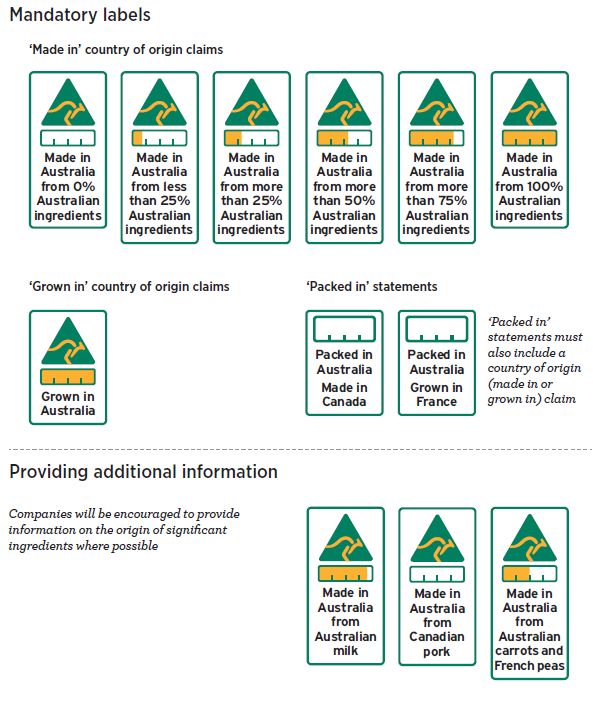The government's new Country of Origin Labelling (CoOL) labelling system has been met with criticism from groups claiming there are still “gaps” of information about the origin of produce.
In February, the government established a review of Australia’s Country of Origin Labelling (CoOL) laws, and foods processed locally will now have a new label which includes the familiar green and gold kangaroo and triangle icon, with a bar chart showing what proportion of the ingredients are from Australia.
This will include statements such as: 'Made in Australia from 100% Australian ingredients', 'Packed in Australia, Made in Canada' and 'Made in Australia from Australian carrots and French peas'. Companies will be encouraged to provide additional information on their labels – identifying the origin of key ingredients, for example.
However, consumer advocacy group Choice said many consumers would still be left wondering where their food comes from. Spokesperson Tom Godfrey said the new system was unhelpful for consumers wanting information about the 195 countries other than Australia, and there were major gaps in information.
“Claims such as ‘Made in Australia from more than 50% Australian ingredients’ will have you asking if your frozen berries come from China, Canada or Chile,” he said.
The Federal Government is also encouraging food manufacturers to provide more information on the origin of significant ingredients. Consumers wanting to buy Australian produce will need to look for the “Grown in Australia” logo or the “Made in Australia from 100% Australian ingredients” logo.
Godfrey believed this was an improvement on the current situation, where so-called qualified claims such as ‘Made in Australia from imported and local ingredients’ left shoppers confused.
“Unfortunately the new system leaves it up to the manufacturers to voluntarily declare the origin of a product’s main ingredient,” he said.
“Choice is deeply concerned global trade agreements might have provided an excuse to deny consumers the full picture of where their food comes from, especially at a time when agreements like the TPP are being finalised in secret. We urge food manufacturers to be more transparent about the origin of their ingredients and take on board the option to list the main ingredients of their products.”
Under the new scheme, if a product is imported into Australia and then re-packed, the label will identify where the item came from.
Horticultural body AUSVEG has expressed its own concerns, claiming the measures do not make it mandatory for specific countries of origin of imported ingredients contained in Australian-manufactured food products to be displayed on labels. AUSVEG also said apps were no substitute for genuine Country of Origin labelling.
“We note the Government has indicated it will investigate online platforms and digital options as a means of providing more information on product ingredients, but this is a woefully inadequate substitute for a genuine system that identifies the country of origin of key ingredients on labels,” said AUSVEG CEO Richard Mulcahy.
Australian Food and Grocery Council CEO Gary Dawson said the CoOL rules recognised the importance of Australian jobs in the food production and processing sector, but the changes would hit small business.
“The retention of the term 'Made in Australia' and wider use of the well-known ‘Australian Made’ logo underlines the value of the more than 300,000 jobs in Australia’s food and grocery processing sector, with almost half of those jobs in rural and regional areas,” Dawson said.
“It will be important for the government, during the implementation phase, to understand the cost, complexity and additional red tape that these changes will impose, with the burden falling hardest on small business and those companies affected by seasonal variations in their sourcing.
“A flexible and practical approach will be essential during the transitional phase.”
Aussie Farmers Direct CEO Keith Louie hoped the new regime would stop manufacturers hiding the origin of food.
“While we don't believe any food or grocery line with less than 90 per cent of Aussie ingredients should be associated with the ‘Made in Australia’ label, the new labelling at least gives clarity around the percentage of local ingredients and will help customers make an informed decision,” he said.
The company recently launched its own marketing campaign aimed at educating Australians on the origins of their food.
The Commonwealth Government will continue to work with states and territories, whose agreement is required to roll out the new labels. An initial voluntary take-up of the country of origin food labels will mean shoppers should see changes on the shelves later this year.
The mandatory rollout will commence in 2016, providing manufacturers with time to implement the new scheme. There will be a phased implementation period for small business.








